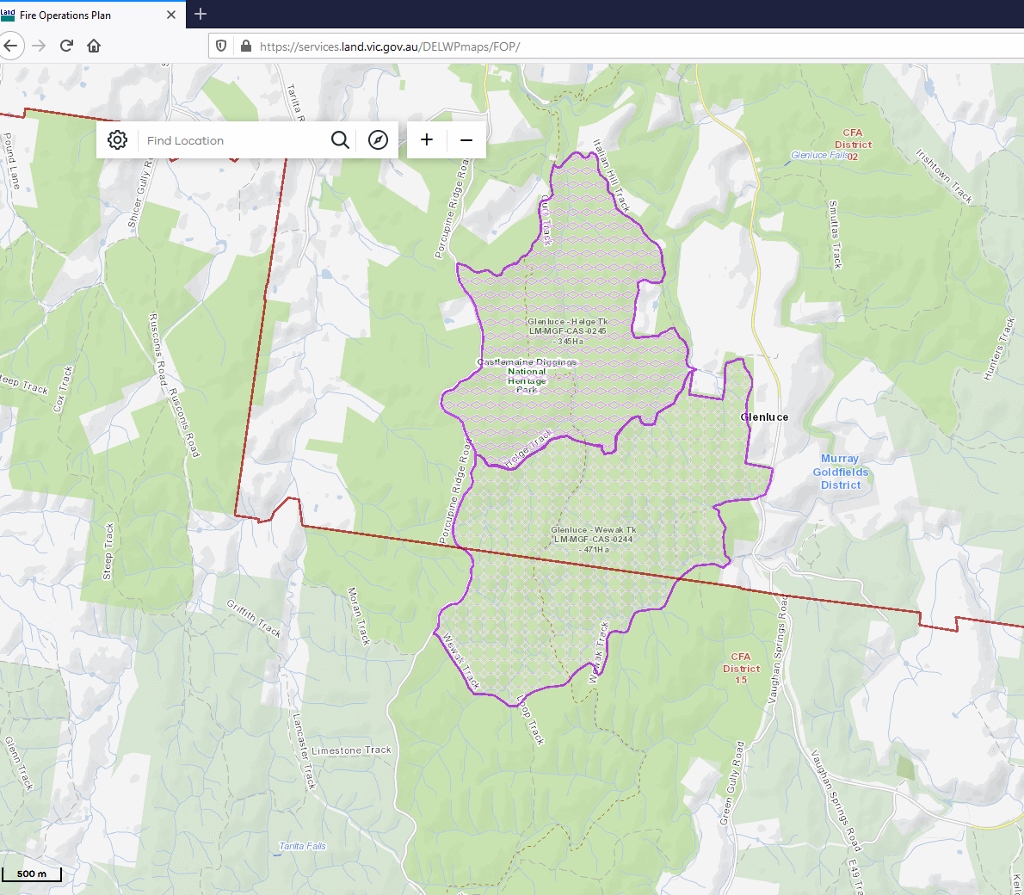As a follow up to Rob Simons’ recent correspondence with Forest Fire Management about two proposed burns in the Diggings Park (see the comment at the end of our last week’s post), FOBIF has written to DELWP’s Acting Regional Fire Manager, asking for a few details about the burns, which are slated for 2022 and 2023.

The two proposed burns are east of the Porcupine Ridge road, in the south end of the Diggings Park.. FOBIF is critical of two previous burns in this area, and is hopeful the Department can improve its performance this time around.
The letter reads:
A few questions arising from your recent exchange with Rob Simons about the two planned burns CAS 0244 and CAS 0245.
These two blocks are of course close to or contiguous with two previous Department burns, Tarilta valley and Loop Track, burned eight and ten years ago. You may remember we had an exchange of letters on the matter at the time.
On these burns there are in our opinion two undeniable facts:
- The Tarilta burn was followed by rain which washed a very large amount of soil off the valley sides and into the creek. We couldn’t quantify the soil loss, but the mud in the creek was up to the waist a week after the fire, and the Limestone Track causeway was blocked.
- The Loop track fire killed a significant number of big trees, and has resulted in rampant and dense regrowth of wattles and eucalypts. It’s now one of the few areas in the region where it’s almost impossible to walk any significant distance without a struggle. The vegetation load in this block is heavier than in adjoining unburned areas.
In both cases the outcomes were the result of fires that were arguably too hot; and in the case of the Tarilta fire, the serious soil loss was a direct result of stripping vegetation from steep valley sides a few days before forecast heavy rain.
I have an extensive collection of photos taken soon after the burns.
My questions are:
- What were the conclusions of post fire monitoring after the above two exercises [both as to ecological effects and fuel reduction]?
- What lessons have been drawn from the monitoring?
- How will the management of the upcoming burns be different [if they will]? I note, for example, that the two blocks contain significant areas of creekline vegetation and damp forest]
Sincerely,
Bernard Slattery
FOBIF Secretary
*****************
We’ll let readers know when we get an answer.




 Click on image for info/order page
Click on image for info/order page Click on image for info/order page
Click on image for info/order page Click on image for info/order page
Click on image for info/order page





















This whole burning attitude has become an industry, and like any other disturbance has consequences for succession to undesirable outcomes. The myth that cultural burning will somehow ” restore” an eco system should be challenged for the evidence, especially in brittle highly modified environments such as the box ironbark country. Nowhere is there a mention of just leaving it alone to self regulate. The facts are that exotic grasslands are the the most flammable and act as vectors to move fire through the landscape very fast with catastrophic outcomes.
Perhaps i will be corrected but i have always been told by historians and indigenous peoples alike that local first nations gained nothing from burning the forests – in particular the box ironbark forests, and therefore traditionally have never done this. This idea of burning it back to health is something I would find difficult to support or have any confidence with.